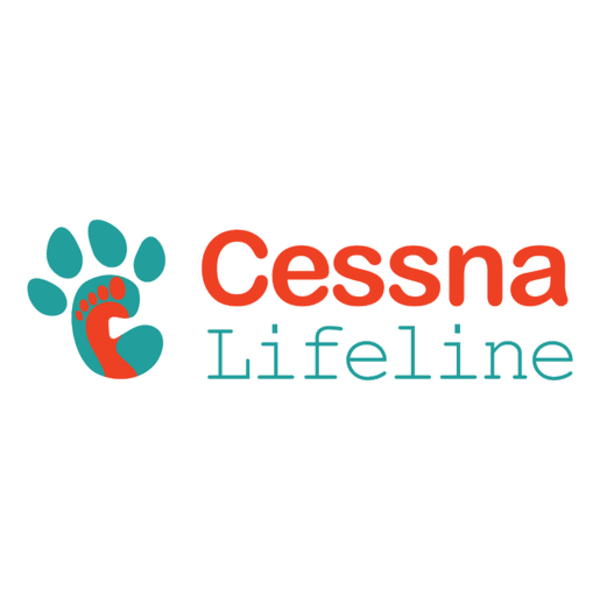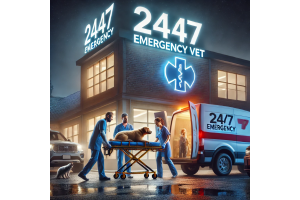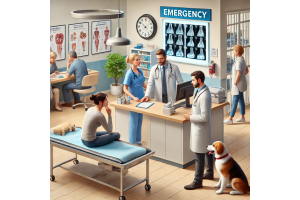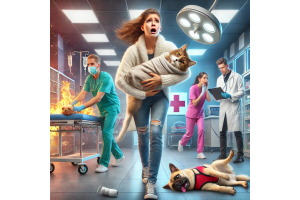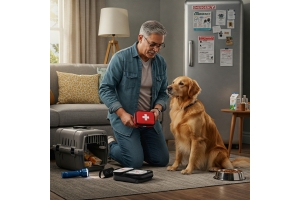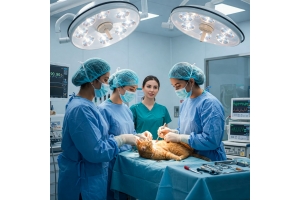Back to Top
Chronic Kidney Disease (Chronic Renal Failure)
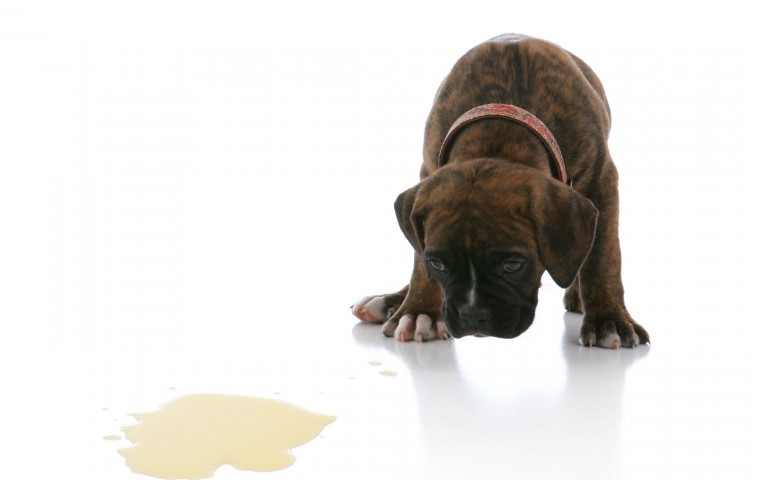
About the Diagnosis
Cause: A dog or a cat, like a person, has two kidneys, which are located in the belly(abdomen). The kidneys produce urine, which is carried away from the kidneys in thintubes, the ureters, to the bladder and then voided out the urethra.
The main function of the kidneys is to eliminate waste substances from the bloodstream
that are produced as part of the body’s normal functions every day.
Normally, a kidney is oval and is roughly the size of a chicken’s egg in a medium-size
dog. The kidneys are essential to life. It is possible to live with just one healthy kidney,
but if both kidneys stop working altogether (a situation referred to as acute renal failure),
an individual will not survive unless the kidneys are made to start functioning again.
The normal, healthy kidney tissue is made of a variety of cells types that form the
microscopic functional unit of the kidney, the nephron. The nephron is composed of the
glomerulus, where the blood is filtered; various segments of renal (kidney) tubules,
where metabolic waste is excreted or removed and materials needed by the body are
reabsorbed; and the collecting ducts, where final alterations are made in the formation
of urine. In addition to filtering the blood, the kidneys are also responsible for
maintaining the body’s water, electrolyte, and acid-base balance, as well as producing
and releasing hormones that play an important role in controlling systemic blood
pressure, red blood cell production, and parathyroid hormone levels.
Chronic kidney disease (CKD, formerly called chronic renal failure) is the name given
to the medical condition where the kidneys are not functioning adequately; “renal”
simply means “related to the kidneys.” Kidney tissue damage may be temporary or
permanent. However, like certain other organs (such as the brain and the heart), kidney
tissue that is permanently damaged cannot be replaced by the body. Therefore, the
goal of treatment of chronic kidney disease is to prevent permanent damage and to
allow temporarily damaged kidney tissue to recover.
Detectable signs of CKD first occur when approximately 75% of the nephrons of both
kidneys cease to function. This means the kidneys have a great deal of reserve and
may tolerate damage for months or years without producing visible symptoms.
Unfortunately, this also means that kidney disease can be ongoing for a long period of
time before this threshold is reached and symptoms of failure are noticed.
CKD can occur for a variety of reasons (see below), but the final result is the same: the
kidneys fail to perform their main function of filtering the body’s waste products out into
urine. Abnormal filtration results in an accumulation of waste products and toxins in the
blood, triggering a sense of lethargy, loss of appetite, and nausea. Failure to produce
kidney hormones can result in high blood pressure, a decrease in red blood cell
production resulting in anemia, and secondary hyperparathyroidism (increased levels of
parathyroid hormone).
CKD is a potentially serious and life-threatening disease, but it has many degrees of
severity. It is characterized by kidney dysfunction that deteriorates progressively. Some
animals diagnosed early respond very well to treatment and can live very comfortably
with a normal life span. In other cases, the onset of symptoms can be so sudden and
severe that CKD can progress to acute renal failure and be the cause of death within
days to months of diagnosis.
CKD is a common problem in all breeds of cats and dogs. Animals of any age and
either sex can be affected; however occurrence of CKD increases with age.
Although the cause (etiology) of CKD is often unknown, there are several different
diseases in cats and dogs which potentially can lead to kidney failure: hereditary and
Congenital malformations of the kidneys (renal dysplasia), immune system
abnormalities, toxins, poor blood flow and lack of oxygen (ischemia) to the kidneys,
inflammatory or infectious diseases, cancer (neoplasia), and urinary tract obstructions.
Diagnosis
Symptoms of CKD can vary from patient to patient and are often common to several
other diseases that are completely unrelated to kidney disease. That is, the symptoms
of kidney disease are nonspecific. Therefore, an important step for using the correct
treatment is to confirm that kidney disease, and not an impostor, is the cause of
symptoms.
Your veterinarian will begin by asking you several questions to try to determine if
chronic kidney disease, or another type of problem altogether, could be responsible for
symptoms. You should provide whatever information you have when you answer these
questions, which often include: the type of symptoms you have observed, the length of
time they have been occurring, effects on vital functions such as appetite and urine
elimination, the possibility of exposure to potentially poisonous substances (such as car
antifreeze) in the past, and any current medications or supplements you are giving your
pet.
When examining your pet, your veterinarian will look for some of the changes that can
occur with chronic kidney disease, which include poor body condition, dehydration, bad
breath, oral ulcers, loose teeth, pale gums, and kidneys that can be felt with the
fingertips to be small and irregular.
If CRF is suspected by your veterinarian, further testing will be recommended since
none of these symptoms are exclusive to CKD.
Lab work consisting of blood and urine tests is typically recommended in order to
diagnose CKD as well as rule out other possible medical problems that produce similar
symptoms. A complete blood count (CBC), biochemical profile, and urinalysis are the
tests of choice. Your veterinarian should be able to acquire samples for these tests in a
short period of time. For the urine test, a needle is often used for removing urine directly
from the bladder in order to get the most sterile or clean sample. The urine sampling
procedure (cystocentesis) is similar to an amniocentesis in a pregnant woman: it is done
easily, does not cause significant discomfort, and involves very little risk.
Imaging techniques including x-rays and/or ultrasound are also commonly performed.
These tests can help to rule out many other disease processes, which could drastically
affect the treatment plan and long-term outlook (prognosis).
Other tests that may be performed depending on the case can include: urine culture and
sensitivity, blood pressure, blood gas analysis, urine protein/creatinine levels, serologic
tests, specialized x-rays (contrast imaging), and kidney fine-needle aspirate or biopsy.
These tests may aid in determining an underlying cause and/or the severity of disease
in some cases.
Often, not all these tests are needed, and your veterinarian can explain which, if any,
are recommended, and the reasons for performing them in your pet’s case.
Living with the Diagnosis
An increase in thirst and urination are common early signs of CKD. This is a common
misconception since many people assume that if a pet is producing a large amount of
urine that the kidneys must be working well. In fact, the opposite is true: when the
kidneys start to fail, they are unable to retain the correct amount of the body’s fluids,
and large volumes of urine (polyuria) are the result.
If kidney function deteriorates over time, weakness, decrease in activity, vomiting,
diarrhea, a decrease in appetite, weight loss, lack of coordination when walking,
dehydration, oral ulceration, and bad breath are often seen. In the terminal stages of
renal failure, severe dehydration, vomiting, convulsions, and coma can lead to death.
CKD is a potentially serious and life-threatening illness. During the course of the
disease, it is very important to keep all recommended follow-up appointments and lab
tests with your veterinarian in order to monitor the progression of disease, screen for
complications to address them early if they occur, and make any needed medication
adjustments. At home, by monitoring your pet’s weight (if possible) as well as changes
in drinking, urination, and appetite, you will learn helpful information to bring to your next
appointment.
Give all prescribed medications as directed by your veterinarian. Medications help to
slow the worsening of disease as well as improving the quality of your pet’s life. Most of
these medications will be required for the rest of the pet’s life.
Always provide unlimited access to fresh clean water. Ask your veterinarian for some
ideas on how to encourage your pet to take in more water, which helps prevent
dehydration and keeps the kidneys functioning as well as possible.
You should discuss an ideal diet for your pet with your veterinarian and try to feed only
the recommended foods. If your pet is no longer willing to eat the special diet, contact
your veterinarian prior to changing foods. An adequate level of nutrition is extremely
important in the treatment of kidney disease.
Treatment
The goal of treatment is to reduce the kidney’s workload and the symptoms associated
with decreased kidney function, prevent or slow any deterioration of kidney function,
and improve the quality of the pet’s life.
Treatment of CKD must be based on the individual patient, the severity of the
symptoms, the underlying cause, and the secondary complications or concurrent
diseases that may be involved. In every patient, however, all medications that
potentially could have harmful side effects to the kidneys should be identified and
discontinued, and all underlying diseases should be diagnosed and treated.
Patients with severe symptoms of CKD often need to be hospitalized initially while
intravenous (IV) fluids are given to correct dehydration, electrolyte, and acid-base
abnormalities and medications are initiated. If hospitalization is not required, your
veterinarian can start your pet on medications and you can give the treatments at home.
Diets and treats that have a reduced quantity and higher quality of protein content, as
well as reduced phosphorus and sodium, are ideal for patients with CKD. These diets
are formulated to decrease the kidney’s workload and also help reduce high blood
pressure (hypertension), which is a common problem in animals with CKD. Several
specially-formulated commercial veterinary diets as well as homemade recipes are
available.
Home-cooked diets should be formulated by veterinarians, and many online sources are
available, including www.balanceit.com and www.petdiets.com. Remember that the
internet is a “buyer-beware” zone and manydiets that are not formulated by
veterinarians are imbalanced and harmful, even if their claims and testimonials sound
very appealing. Appetite stimulants may also be beneficial in cats who are not eating
well.
Fresh, clean water should always be available to your pet. In some instances, your
veterinarian may suggest periodic injections of fluids by subcutaneous (under the skin)
injection. This can be performed at the veterinary clinic. If your pet needs the injections
every day or several times weekly to help prevent dehydration, the veterinary staff may
offer to show you how to give this type of treatment to your pet yourself at home. With
practice, this can be a simple and rewarding procedure, especially if your pet knows you
will give him or her a treat afterwards. Be sure that you are comfortable doing so before
taking this task on, and that your pet tolerates this procedure so you do not put yourself
in a position of risk of being bitten, scratched, or otherwise harmed. If there is a
possibility that your pet might harm you, be sure to tell this to the veterinarian ahead of
time so a different approach can be chosen.
Vomiting, stomach upset, and poor appetite can be treated with antinausea medications
as well as antacids. If excessive phosphorus levels are still evident on blood tests once
the proper diet has been established, phosphate-binding gels containing aluminum
hydroxide can be administered by mouth.
Secondary problems such as high blood pressure, anemia, and hyperparathyroidism
are fairly common, and if one or more is/are present, your veterinarian will choose the
most appropriate treatments based on the severity of symptoms and your pet’s specific
needs.
Peritoneal dialysis and hemodialysis are also being successfully performed in cats and
dogs at selected referral hospitals.
Not all of the medications or treatments described above are necessary for every animal
with CKD, and some treatments may be changed if the kidneys improve or deteriorate
in function.
DOs
Realize that chronic kidney disease does not mean the kidneys have stopped working
entirely. Rather, chronic renal failure is a condition in which the kidneys are not
functioning enough, which can lead to symptoms related to waste product accumulation
in the bloodstream, such as loss of appetite, sluggishness, and vomiting.
Contact your veterinarian, if your pet’s symptoms change, worsen, or any new problems
arise.
Have your veterinarian or veterinary technician show you how to give all medications
and demonstrate the correct method for subcutaneous fluid administration if injectable
fluids are part of the treatment plan. Never reuse needles.
Give all medications exactly as directed by your veterinarian. If you believe your pet is
having side effects from any medications or you are finding it very difficult to medicate
your pet, contact your veterinarian for advice before discontinuing the treatment.
Ask your veterinarian questions about information you do not understand.
Consider humane euthanasia if your pet is not responding to all possible treatments and
you feel he or she is suffering or has a poor quality of life.
DON’Ts
Do not postpone a visit to your veterinarian if you observe any symptoms of illness or of
CKD since early diagnosis and treatment can aid in preventing the progression of
disease and improving the quality of your pet’s life. The initial screening only requires a
physical exam and routine blood and urine tests.
Do not assume that drinking and urinating normal or higher-than-normal amounts
indicates good kidney function. In fact, one of the earliest symptoms of chronic renal
failure is an increase, not a decrease, in water consumption and urination.
Do not give any medications that are not prescribed by your veterinarian for the specific
pet in question.
Do not stop any medications if your pet is feeling better without consulting with your
veterinarian first.
Do not assume that all sources of information are accurate or complete (e.g., many
internet sites, outdated pamphlets or books, pet store workers, friends). Ask your
veterinarian for recommended sources of information.
If you are giving treatments at home, do not dispose of needles or syringes in the trash.
Rather, collect them in a puncture-proof container and bring them to your veterinarian
for disposal in accordance with local laws.
When to Call Your Veterinarian
If you are unable to give medications as prescribed or if you require a prescription refill.
When you have any questions or concerns related to your pet’s continual treatment plan
or current status.
Signs to Watch For
As indicators of kidney disease in general, and indicators of increased symptoms of
CKD specifically:
Watch for general sign of illness, which can include changes in appetite, weight loss,
decrease in activity, depression, dull or poorly kept coat, and changes in behavior such
as hiding and aggressiveness.
Watch for signs of CKD, which can include an increase in thirst (Are you filling up the
water bowls more often? Is your animal drinking water from taps, bath tubs, fountains,
etc.?) and urination (Is your animal asking to go outside more frequently or having
accidents in the house? Do you notice larger urine spots in the litter box, or do you have
to change the box more frequently than usual?), vomiting, diarrhea, dehydration,
weakness, lack of coordination when walking, oral ulceration, bad breath, pale gums,
convulsions, and coma.
Routine Follow-Up
As CKD is an ongoing disease that can deteriorate over time, it is important to keep all
recommended follow-up appointments and lab tests with your veterinarian in order to
monitor the progression of disease, document and treat any new problems that may
arise, and make any needed medication adjustments.
